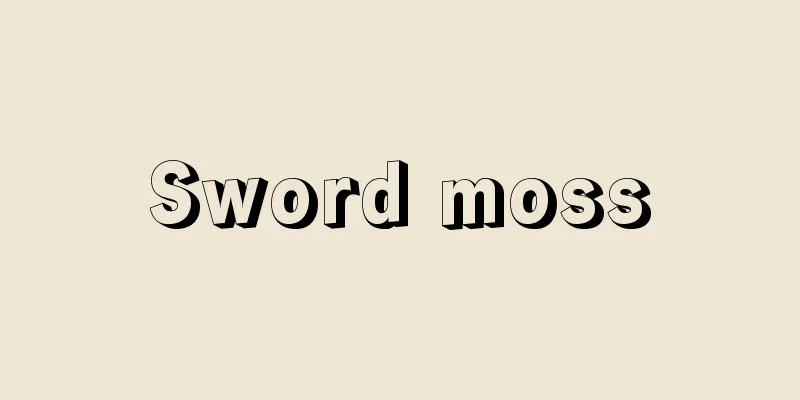Picture scroll - emaki

|
One of the uniquely Japanese art styles, also known as emakimono (picture scrolls). Using kotobagaki (text) and pictures, they unfold stories, tales, biographies, and legends of shrines and temples that were popular in Japan from ancient times to the Middle Ages, and were made into scrolls to be preserved and appreciated. They continue to be used as a form of Japanese painting to this day, but here we will focus on the so-called Yamatoe emaki, which were produced from the 10th century (Heian period) to the 16th century (Muromachi period) and were mostly painted in the Yamato-e style. [Hideo Okudaira] ContentsIn terms of content, picture scrolls can be divided into two categories: religious picture scrolls, which have religious content, and aesthetic picture scrolls, which have primarily aesthetic content. The religious scrolls include the following: (1) Illustrated explanations of Buddhist scriptures, such as the Kegon Illustrated Scroll, the Twelve Links of Dependent Origination Scroll, Jigoku Soshi, and Hungry Ghost Scroll. (2) Legends describing the origins of the founding of Buddhist temples and shrines, and the miraculous powers of the deities and Buddhas that are the principal objects of worship there - such as "The Origins of Mount Shigi," "The Origins of Kokawa-dera," "The Origins of Taima Mandala," "The Origins of Ishiyama-dera," "The Origins of Kiyomizu-dera," "The Origins of Kitano Tenjin," "The Origins of Matsuzaki Tenjin," and "The Miracle Record of Kasuga Gongen." (3) Biographies or anecdotes about people related to religion: "Illustrated Biography of the Kegon Sect's Founder," "Illustrated Biography of the Eastern Expedition," "Illustrated Biography of Honen Shonin," "Illustrated Biography of Shinran Shonin," "Illustrated Words of Longing," "Illustrated Biography of Ippen Shonin," "Illustrated Biography of Prince Shotoku," "Illustrated Scroll of the Tale of Saigyo," etc. In contrast, examples of aesthetic picture scrolls include the following: (1) Stories and diaries based on the romantic literature of the Heian period or the pseudo-classical literature of the Kamakura period which is a descendant of the romantic literature of the Heian period: Illustrated Scroll of the Tale of Genji, Illustrated Scroll of the Tale of Nezame, Illustrated Scroll of the Diary of Murasaki Shikibu, Illustrated Scroll of The Pillow Book, Illustrated Scroll of the Imperial Proceedings of Horse Racing, Illustrated Scroll of the Tales of Ise, Illustrated Scroll of Ono no Yukimi Goko, etc. (2) Tales based on strange incidents or humorous tales: "Ban Dainagon Ekotoba," "Kibi Daijin Nittou Emaki," "Eshi Soshi," "Hase Okyo Soshi," "Haisumi Soshi," etc. (3) Fairy tales from the Muromachi period and other fairy tales based on similar tales: Fukutomi Zoushi, Twelve Rule Picture Scrolls, Ameno Wakahiko Zoushi, Nezumi Zoushi, Ashibiki Zoushi, Tawara Touta Picture Scroll, and Monster Zoushi. (4) War chronicles on the subject of famous historical battles: "The Tale of Heiji Illustrated Scroll," "The Zenkunen War Illustrated Scroll," "The Gosannen War Illustrated Scroll," "The Mongol Invasion Illustrated Scroll," "The Yuki Battle Illustrated Scroll," etc. (5) Waka poems depicting people and landscapes that serve as the background for the poems: "Illustrated Scroll of the Thirty-six Immortal Poets," "Illustrated Scroll of the New Famous Places of Ise Poetry Contest," "Illustrated Scroll of Tohoku-in Craftsmen Poetry Contest," "Illustrated Scroll of the Thirty-two Craftsmen Poetry Contest," etc. (6) Records depicting portraits or events of historical significance: "Portraits of the Emperor and the Minister of State," "Scroll of Portraits of Courtiers," "Scroll of an Assembly of the Empress," "Scroll of Annual Events," "Scroll of Attendants on Garden Rises," "Scroll of the Swift Cattle," "Bai-soshi," etc. In addition to these, there is another work that does not fall into any of the above categories, such as "Choju Jinbutsu Giga." As mentioned above, picture scrolls can be divided into various types in terms of subject matter, but looking at them generally, it can be said that the majority have narrative or preaching content. Furthermore, the background is generally human-centered, with a strong emphasis on human life and the joys and sorrows of human life. In this sense, picture scrolls can be said to combine elements of both narrative painting and genre painting. [Hideo Okudaira] formatEmaki scrolls are made by joining together several or even dozens of sheets of paper (or occasionally silk), and are most often around 30 to 39 centimeters in length. Most often, they are also 9 to 12 meters in width. Most scrolls consist of one, two, or three volumes, but there are also some large ones with twelve, twenty, or even forty-eight volumes. Generally speaking, emakimono (picture scrolls) are taken to mean scrolls containing only pictures, due to the sense of the word, but almost all emaki scrolls contain both words and pictures (though there are exceptions, such as Choju Jinbutsu Giga, which contains only pictures and no words). There are various ways of writing them, but the most common format is to write the words first, then draw the corresponding pictures, and repeat this format to progress the narrative. This alternating arrangement of words and pictures is the standard format for Japanese emaki scrolls. Because emaki scrolls are scrolls, the basic rule is that they should be placed on a desk, opened with the left hand and rolled with the right, while slowly moving your eyes from right to left as you look at them. The basic requirement for appreciating emaki scrolls is to look at them slowly, moving the picture plane with your own hands in this way, and by doing so, a temporal and spatial development is created on the screen. This is what distinguishes emaki scrolls from folding screen paintings, sliding door paintings, hanging scroll paintings, and other similar works. As mentioned above, the narrative of an emaki scroll is created by alternating words and pictures, but there are two types of composition for the pictures: paragraph-style and continuous-style. Paragraph-style composition refers to a composition in which the screen is cut into short, illustration-like sections (such as the Tale of Genji Emaki), and is suitable for quietly appreciating the appeal of each scene. In contrast, continuous-style composition refers to a composition in which several scenes are depicted one after the other to create a long screen (such as the Shigisan Engi), and is suitable for depicting events that develop over time. In fact, the beauty of the emaki scroll format is often brought out by this continuous-style composition. Many picture scrolls attempt to depict scenes from a bird's-eye view, which is thought to have been attempted because the width of the picture surface of a picture scroll is narrow, and it was necessary to include many people, objects, and nature, and to depict the movements of the people in detail. A bold painting technique was also invented, such as "fukinuki yatai," which depicts the interior patterns of a building from a bird's-eye view, omitting the roof and ceiling of the building. Also, emphasis is placed on depicting the main characters, and in order to do so, the laws of proportion and perspective with the surrounding background are broken, and the main characters are often depicted particularly large. [Hideo Okudaira] StyleGenerally, picture scrolls are painted in the Yamato-e style. Yamato-e was created in the mid-Heian period as a style of painting suitable for expressing Japanese customs and nature, breaking away from the continental styles of painting that had influenced it up until then, especially those of China's Sui and Tang dynasties. It is inseparably linked to emakimono, which are centered on Japanese subjects. As the subjects of picture scrolls became more diverse and their contents more abundant, the Yamato-e styles used to express them also became more diverse and the techniques more complex. One representative example of this style is the "tsukuri-e" seen in the Tale of Genji Emaki. This is a type of decorative painting style in which the entire screen is filled with dark colors and the outlines are drawn with thin lines, and the faces of the figures are painted with unrealistic expressions, with "hikime kagi hana" (eyes that turn down, noses that turn up). The elegant colors and quiet facial depictions create a very sentimental effect on the screen. Works based on narrative illustrations, such as "Nezame Monogatari Emaki" and "Murasaki Shikibu Nikki Emaki," generally belong to this lineage. In contrast to this style is "Shigisan Engi," which uses only light colors and places emphasis on line drawing, emphasizing the movement of lines by making full use of thick and thin lines. While "The Tale of Genji Illustrated Scroll" is static and sentimental, this is dynamic and dramatic, and while "The Tale of Genji Illustrated Scroll" is lyrical, this is narrative. Works that belong to the same lineage as "Shigisan Engi" include "Konkawa-dera Engi," "Hell Story," "Gaki Story," and "Yamaino Soshi." There are many works that place emphasis not on either color or line, such as the Tale of Genji Illustrated Scroll and Shigisan Engi, but on both, and in fact, the later the style became more and more eclectic. Among these, the Tale of Heiji Illustrated Scroll and Ban Dainagon Ekotoba are particularly excellent works. Next, the "Hakubyo" style of painting, which is mainly drawn using lines in a single color of ink, is typified by the "Choju Jinbutsu Giga" and the "Makura no Soshi Emaki." However, even though they are both hakubyo, they each have different characteristics and effects. The "Choju Jinbutsu Giga" vividly depicts the movements of birds and animals with light, flowing lines that vary in thickness. In contrast, the "Makura no Soshi Emaki" is composed of extremely fine contours and ink-colored surfaces with varying degrees of lightness and darkness, and develops a world of graceful charm through the use of black and white tones. Emaki scrolls are painted in various styles as mentioned above, but in general, they are characterized by a gentle and elegant style. In contrast to emaki scrolls painted in the Yamato-e style, scrolls painted in styles other than Yamato-e (such as Chinese painting) are called gakan or zumaki, and are not called emaki. For this reason, some people refer to emaki scrolls strictly as Yamato-e emaki. [Hideo Okudaira] AuthorVery few picture scrolls state the name of their artist, but the artists known from documents and remains come from all walks of life, including emperors, members of the imperial family, nobles, courtiers, learned monks, artists, and Buddhist sculptors. Among the surviving works, Tokiwa Mitsunaga, the author of "Ban Dainagon Ekotoba," Takashina Takakane, the author of "Kasuga Gongen Miraigenki," and Tosa Mitsunobu, the author of "Kiyomizu-dera Engi," are artists from the imperial court's painting studio, while Shiba Rinken, who painted "Daibutsu Engi," was an Buddhist sculptor from the Kofuku-ji painting studio. En'i, the author of "Ippen Shonin Eden," and Ren'yo, the author of "Tosei Eden," are also thought to be Buddhist sculptors. The author is not aware of such classic works as "The Tale of Genji Illustrated Scroll," "The Legend of Shigisan," and "The Picture Book of Birds and Animals," but they are all thought to have been painted by first-class professional artists. In addition, it is thought that there were also independent painters who had no connection to either the imperial court or temples. For example, among the Otogi-zoshi picture scrolls from the Muromachi period, there are many works that seem to have been painted by unknown town painters. Although it is not possible to give a clear figure for the number of painters who put their brushes to work on picture scrolls, it is believed to have been a considerable number. [Hideo Okudaira] Historical developmentsThe picture scroll format was originally introduced from China. Therefore, it must be assumed that picture scrolls began to be made in Japan due to Chinese influence. It is thought that picture scrolls with Japanese themes were created in Japan around the 10th century, so it is safe to say that before that, picture scrolls with Japanese themes were modeled after those that had been introduced from China, and that the foundation for creating domestic picture scrolls was laid before that. The oldest relic of the picture scroll format that has been passed down in Japan today is the Illustrated Sutra of Cause and Effect (Eingakyo) from the Nara period (8th century), which was copied by a Japanese artist based on a text that had been introduced from China. Considering the state of affairs in the Buddhist world at that time, it is likely that various works of this type were imported to Japan, followed by the Tang Dynasty's decorative picture scrolls. It is safe to say that after the period of the transplantation of Chinese picture scrolls, picture scrolls with unique Japanese content and style were finally produced in the Heian period. The period when picture scrolls flourished was roughly from the 10th to 11th centuries in the late Heian period, which corresponds to the rise of the national culture after the abolition of the Japanese missions to Tang China. Although no remains of picture scrolls from this period remain, their appearance and content can be roughly understood from articles in stories, poetry collections, and other sources from the period. Among them, the articles in The Tale of Genji (such as the Kiritsubo, Suma, Eawase, and Hotaru chapters) are of great help, and we can see that picture scrolls were actively appreciated and produced among the aristocratic society of the imperial court at that time (the first half of the 10th century, the Engi and Tenryaku periods). There were many different types of picture scrolls, including diary scrolls, four seasons scrolls, annual event scrolls, narrative scrolls, and storytelling scrolls, and we can see that many of them incorporated Japanese themes. In short, this article in The Tale of Genji proves that picture scrolls from the first half of the 10th century were aristocratic in style, rich in decorative beauty, and had a great deal of narrative and secular content. The fact that their content was rich in narrative was likely due in large part to the influence of narrative literature that emerged during this period, and this narrative nature in content has been passed down to future generations as a distinctive characteristic of Japanese picture scrolls. The picture scroll that emerged in this way gave birth to many masterpieces in the late Heian period, in the 12th century. These include "The Tale of Genji," "The Origins of Mount Shigisan," "Ekotoba of Ban Dainagon," and "Choju Jinbutsu Giga." These works are not only representative of the mainstream of the picture scroll lineage, but are also significant in that each creates a separate world using different techniques and styles. All four of these works are masterpieces that rank among the finest among surviving picture scrolls, and it is no exaggeration to say that the 12th century, which produced so many masterpieces, was truly the golden age of picture scrolls. The golden age gave way to the next Kamakura period (13th-14th century), when picture scrolls became popular. The contents were more diverse than in the previous period, including appreciation-oriented works based on narrative literature, legendary tales, waka poetry, and war stories, as well as religious works based on the origins of shrines and temples and biographies of patriarchs. As the content of picture scrolls became richer, the types of characters that appeared also became more diverse, and in addition to the aristocracy, many people were depicted, including monks, samurai, farmers, craftsmen, prostitutes, and beggars. The setting also became more extensive than in the Heian period, including not only cities but also remote mountain villages, giving the picture scrolls a more regional color. As the content and subjects became richer and more diverse, the styles of painting to express them also became more diverse, and several styles of Yamato-e were created. Of the well-known works that remain today, those from the Kamakura period are the most numerous in terms of both variety and quantity. This is because picture scroll production was supported not only by the traditional aristocracy, but also by monks and the samurai class, and it was through this support that picture scrolls were able to represent the glamorous and fashionable times. However, by the time of the following Muromachi period (15th-16th century), picture scrolls had finally passed their prime and entered a period of decline. The picture scrolls of this era no longer had the vitality and freshness of the previous era. There was nothing new in terms of content, and the techniques became increasingly stagnant. In other words, Yamato-e, which had been the mainstay of picture scrolls up until that point, also became shriveled and lost its vitality during this period. During this period of stagnation for Yamato-e, Chinese painting, which was a descendant of Chinese Song and Yuan painting, began to take its place, and it was this Chinese painting that dominated the art world of the Muromachi period. As this new style of painting from China flourished, Yamato-e, which was in a state of stagnation, retreated further and further, and it can be said that the Muromachi period marked the end of picture scrolls. Thus the history of emaki scrolls comes to an end, but paintings in scroll format continued to be created into the early modern period, and a small number have been produced from the Meiji and Taisho periods up to the present day. However, in the context of Japanese art history, emaki refers specifically to works painted in the Yamato-e style, and the 16th century is set as the period when that style fell into decline, so the definition of emaki refers to works produced up to the 16th century. Emaki scrolls have left a glorious mark in art history, but we would also like to add that they are indispensable cultural assets as materials for learning about the customs and lifestyles of ancient and medieval Japan. [Hideo Okudaira] "Study of Picture Scrolls" by Ueno Naoaki (1950, Iwanami Shoten)" ▽ "Emaki" by Okudaira Hideo (1957, Bijutsu Shuppan-sha)" ▽ "Emaki" by Mushanokoji Jo (1963, Bijutsu Shuppan-sha)" ▽ "Japanese Art 2: Picture Scrolls" edited by Okudaira Hideo (1966, Shibundo)" ▽ "Primary Color Japanese Art 8: Picture Scrolls" by Akiyama Mitsukazu (1968, Shogakukan)" ▽ "Considerations on Picture Scrolls" by Umezu Jiro (1968, Chuokoron-Bijutsu Shuppan-sha)" ▽ "Newly Revised Complete Collection of Japanese Picture Scrolls" 30 volumes and 2 supplementary volumes (1975-1981, Kadokawa Shoten)" ▽ "Complete Collection of Japanese Picture Scrolls" 26 volumes and 1 supplementary volume (1977-1979, Chuokoron-Shinsha) [Reference] |"Tsukama Gaki" (Replica held at the National Diet Library ) "Gaki Zoushi" The Flying Storehouse Chapter. This is the beginning of the story, in which the bowl that Myoren flew away carries the rice storehouse of the rich man of Yamazaki to Mount Shigisan. Copy owned by the National Diet Library . "Shigisan Legend Scroll" Volume 2 (copy held at the National Diet Library ) "Illustrated Tales of Longing" Suzaku-in, a monk, visits Rokujo-in out of concern for his beloved daughter, Third Princess. Troubled by her affair with Kashiwagi, Third Princess begs her father to let her become a monk. Genji is also saddened by the misunderstandings he has with his wife, Third Princess. The anguished feelings of the three men are symbolically expressed by the mismatched lines of the folding screen. Copy owned by the National Diet Library . "The Tale of Genji Illustrated Scroll" (Kashiwagi, Vol. 1) Hearing that the Otenmon Gate was burning, the crowd rushed through the Suzakumon Gate to the scene of the fire, then stopped to look up at the smoke. Copy held at the National Diet Library . "Ban Dainagon Ekotoba" The opening part of the story depicts a celebration for the artist's family. Copy held at the National Diet Library . "Eshi Zoushi" "Night Attack at Sanjoden" (Replica) 1798 (Kansei 10) National Diet Library "The Tale of Heiji Illustrated Scroll" Scene of Ashikaga Mochiuji's suicide. Copy by Ise Sadatake, 1768 (Meiwa 5), owned by the National Diet Library . "Illustrated Story of the Battle of Yuki" "The Man with Eye Disease" Copy by Rakushun-in (Taki Motokata) 1854 (Kaei 7) Owned by the National Diet Library "Byouzoshi" Source: Shogakukan Encyclopedia Nipponica About Encyclopedia Nipponica Information | Legend |
|
日本独自の美術様式の一つで、絵巻物ともいう。詞書(ことばがき)(文章)と絵によって、日本の上代から中世にかけて流布した物語、説話、伝記、社寺の縁起(えんぎ)などを展開するもので、巻物に仕立てられて保存・鑑賞された。日本画の一形式として現代に至るまで行われているが、ここでは10世紀(平安時代)から16世紀(室町時代)にかけて制作され、おおむね大和絵(やまとえ)の画風で描かれた、いわゆる大和絵絵巻を中心に述べる。 [奥平英雄] 内容絵巻物は内容のうえからみると、宗教関係の内容をもつ宗教的絵巻と、主として鑑賞的な内容をもつ鑑賞的絵巻の二つに分けられる。 宗教的絵巻には、以下のようなものがある。 (1)仏教の経典などを絵解きした経典類―『華厳(けごん)五十五所絵巻』『十二因縁(いんねん)絵巻』『地獄草紙』『餓鬼草紙』など。 (2)仏寺・神社の創建の由来や、その本尊である神仏の霊験などを描いた縁起類―『信貴山(しぎさん)縁起』『粉河寺(こかわでら)縁起』『當麻曼荼羅(たいままんだら)縁起』『石山寺縁起』『清水寺(せいすいじ)縁起』『北野天神縁起』『松崎天神縁起』『春日権現(かすがごんげん)霊験記』など。 (3)宗教に関係ある人物の伝記または逸話を描いた伝記類―『華厳宗祖師絵伝』『東征絵伝』『法然上人(ほうねんしょうにん)絵伝』『親鸞(しんらん)上人絵伝』『慕帰絵詞(ぼきえことば)』『一遍(いっぺん)上人絵伝』『聖徳太子絵伝』『西行物語絵巻』など。 これに対し鑑賞的絵巻には、以下のようなものがある。 (1)平安時代の浪漫(ろうまん)主義の文学、またはその系統を引く鎌倉時代の擬古文学に題材をとった物語・日記類―『源氏物語絵巻』『寝覚(ねざめ)物語絵巻』『紫式部日記絵巻』『枕草子(まくらのそうし)絵巻』『駒競行幸(こまくらべぎょうこう)絵巻』『伊勢(いせ)物語絵巻』『小野雪見御幸(おののゆきみごこう)絵巻』など。 (2)奇怪な事件、あるいは滑稽(こっけい)な話談などを題材とした説話類―『伴大納言(ばんだいなごん)絵詞』『吉備大臣入唐(きびだいじんにっとう)絵巻』『絵師草紙』『長谷雄卿(はせおきょう)草紙』『掃墨(はいすみ)草紙』など。 (3)室町時代を中心とする御伽(おとぎ)草子や、またこれに類する説話を題材とする御伽草子類―『福富草紙』『十二類絵巻』『天稚彦(あめのわかひこ)草紙』『鼠(ねずみ)草紙』『足引絵巻』『俵藤太(たわらとうた)絵巻』『化物(ばけもの)草子』など。 (4)歴史上の著名な合戦を主題とした戦記類―『平治(へいじ)物語絵巻』『前九年合戦絵巻』『後三年合戦絵詞(えことば)』『蒙古(もうこ)襲来絵詞』『結城(ゆうき)合戦絵詞』など。 (5)和歌を背景とする人物や風景を描き並べた和歌類―『三十六歌仙絵巻』『伊勢新名所歌合(うたあわせ)絵巻』『東北院職人歌合絵巻』『三十二番職人歌合絵巻』など。 (6)歴史的な意味をもつ肖像とか行事などを描いた記録類―『天皇摂関(せっかん)大臣影(えい)』『公家列影(くげれつえい)図巻』『中殿御会(ぎょかい)図巻』『年中行事絵巻』『随身庭騎絵巻』『駿牛(しゅんぎゅう)絵詞』『馬医草紙』など。 なおこのほかに、以上のどの類にも入らないものに『鳥獣人物戯画』などがある。 以上のように、絵巻物は題材的にみると、いろいろな種類に分かれるが、これを概観すると、大半は物語的、もしくは説話的な内容をもっているということがいえる。そしてその背景は概して人間が中心で、人間生活や人世の哀歓が大きく取り上げられている。この意味で絵巻は、多分に説話画的要素と風俗画的要素とを兼ね備えているといえる。 [奥平英雄] 形式絵巻は、数枚あるいは数十枚の紙(まれに絹)を横に継ぎ合わせてつくられており、縦幅はだいたい30センチメートルから39センチメートルくらいまでのものがもっとも多い。そして横の長さも普通9メートルから12メートルのものがもっとも多い。そして巻数としては1巻、2巻、あるいは3巻でまとまったものがもっとも多く、なかには十二巻本、二十巻本、そして四十八巻本という大部のものもある。 一般に絵巻物というと、その語感から、絵だけを描いた巻物というふうにとられがちであるが、絵巻物はほとんどすべて詞(ことば)と絵がかかれている(『鳥獣人物戯画』のように詞がなく絵だけを描いたものは特例である)。そのかき方にはいろいろな形があるが、普通は詞のほうを先に書き、次にこれに対応する絵を描く、そしてこの形を繰り返しながら叙述を進めていくという形式がもっとも多く行われている。この詞と絵との交互配列の形式は、日本の絵巻物の標準形式となっている。 絵巻は巻物仕立てとなっているから、本来は机上に置き、左手で開き右手で巻きながら、右から左へとすこしずつ目を移して見ていくのが原則である。このように画面をじかに自分の手で動かしながら、時間をかけて見ていくのが絵巻物鑑賞の基本条件であって、こうすることによって、画面に時間的・空間的な展開が生ずる。これが、屏風絵(びょうぶえ)、襖絵(ふすまえ)、掛軸画(かけじくえ)などと異なる絵巻物の特徴である。 絵巻の叙述は、前述のように詞と絵とを繰り返すことによって行われるが、絵の構図法としては段落式のものと連続式のものとがある。段落式構図は、画面を挿絵風に短く切った構図(源氏物語絵巻)をいい、一場面一場面の情趣を静かに鑑賞するのに適している。これに対し連続式構図は、いくつもの情景を次々と描き続け、長い画面を構成した構図(信貴山縁起)をいい、時間的に発展する事件を描くのに適している。絵巻物形式の妙味は、むしろこの連続式構図によって発揮される場合が多い。 絵巻の構図には俯瞰(ふかん)描写を試みたものが多く、これは、絵巻の画面の幅が狭いことから、多くの人物、物象、自然を盛り入れ、さらに人物の動きを豊富に写すための必要上試みられたものと考えられる。そして建物の屋根や天井を省いて、室内の模様を俯瞰的に描いた「吹抜屋台(ふきぬきやたい)」というような大胆な画法も発明されている。また主要人物の描写に重点を置き、そのために周囲の背景との比例や遠近の法則を破って、主要人物をとくに大きく描いている場合がしばしばある。 [奥平英雄] 画風一般に絵巻物は大和絵の画風で描かれている。大和絵は平安中期に、それまで影響を受けてきた大陸、とくに中国隋(ずい)・唐の画風から脱して、日本の風俗、自然などを表現するのにふさわしい画風として生み出されたもので、絵巻物のような日本的な題材を中心としているものとは切っても切れない関係にある。そこで絵巻物の題材が多様となり、内容が豊富になるにつれて、それを表現する大和絵の様式も多彩となり、技巧も複雑になっている。そうした様式の代表的なものの一つは、『源氏物語絵巻』にみられる「作り絵」である。これは画面を全部濃い色彩でうずめ、細い線で輪郭を描き起こした一種の装飾画風のもので、人物の顔面は「引目鈎鼻(ひきめかぎはな)」の非写実的な表情に描かれている。その優雅な色彩、静かな顔面描写などは、情趣的な画面効果をよく発揮している。『寝覚物語絵巻』『紫式部日記絵巻』などの物語絵系統の作品は、おおむねこの系列に属する。 これと対照的な様式になるのが『信貴山縁起』で、これは色は淡彩にとどめ、線描に重点を置き、肥痩(ひそう)のある描線を駆使して線のもつ運動性を強調している。『源氏物語絵巻』が静的、情趣的であるのに対して、これは動的、劇的であり、『源氏物語絵巻』が叙情的であるのに対し、これは叙事的である。この『信貴山縁起』の系統に属するものに『粉河寺縁起』『地獄草紙』『餓鬼草紙』『病草紙(やまいのそうし)』などがある。 以上の『源氏物語絵巻』や『信貴山縁起』などのように、色彩と描線のどちらかに重点を置くのではなく、そのどちらにも重点を置いて描いている作品は非常に多く、むしろそういった折衷的な画風で描かれたものが、のちになるほど多くつくられている。それらのなかで『伴大納言絵詞』や『平治物語絵巻』などは、とくに優れた作品である。 次に、ただ墨一色の描線を主にして描いた、いわゆる「白描(はくびょう)」の代表的なものに『鳥獣人物戯画』と『枕草子絵巻』がある。しかし同じく白描といっても、それぞれ違った特徴や効果をもっており、『鳥獣人物戯画』は肥痩のある軽快流暢(りゅうちょう)な描線で鳥獣の動態を生き生きと描いている。これに対し『枕草子絵巻』は、きわめて細緻(さいち)な輪郭線と、濃淡の度を異にする墨色の面とによって構成され、黒白の諧調(かいちょう)によって優艶(ゆうえん)な情趣的な世界を展開している。 絵巻は以上のごとくいろいろな様式で描かれているが、総じて柔和で温雅な画趣が特色といえる。この大和絵の画風で描かれた絵巻に対して、大和絵以外の画風(たとえば漢画など)による巻物は画巻(がかん)あるいは図巻とよんで区別され、絵巻とはよばない。それゆえ絵巻のことを厳格に大和絵絵巻とよぶ人もある。 [奥平英雄] 筆者絵巻物にはその筆者の名前を明記したものはきわめて少ないが、文献や遺品などによって知られる画人は、天皇、皇族、公家(くげ)、廷臣、学僧、絵師、絵仏師などの各階層にわたっている。現存作品で知られる『伴大納言絵詞』の筆者常盤光長(ときわみつなが)、『春日権現霊験記』の高階隆兼(たかしなたかかね)、『清水寺縁起』の土佐光信(みつのぶ)らは宮廷絵所の絵師であり、『大仏縁起』を描いた芝琳賢(しばりんけん)は興福寺絵所の絵仏師である。また『一遍上人絵伝』の筆者円伊(えんい)、『東征絵伝』の蓮行(れんぎょう)らも同じく絵仏師と考えられる。『源氏物語絵巻』『信貴山縁起』『鳥獣人物戯画』などのような典型的な作品も筆者は不詳であるが、どれも一流の専門画家の手で描かれたものと考えられる。 なおこのほかに、宮廷にも寺院にも関係のない、在野の画人も存在していたと想像される。たとえば室町時代の御伽草子類の絵巻のなかには、無名の町絵師の手で描かれたと思われる作品がたくさんある。絵巻物に絵筆を染めた画人の数は、数字的にはっきり示すことはできないが、相当の数に上ることと思われる。 [奥平英雄] 歴史的展開絵巻物という形式は、本来中国から伝わったものである。したがって日本で絵巻物がつくられるようになったのは、当然中国の影響によるものと考えなければならない。日本で日本的題材の絵巻物が生まれたのは、だいたい10世紀に入ってからと考えられるので、それ以前は、いわゆる中国伝来のものを手本にして、自国のものを生み出すまでの下地を養っていた時期とみてよいであろう。今日、日本に伝わっている絵巻物形式の最古の遺品に、奈良時代(8世紀)の『絵因果経(えいんがきょう)』があるが、これは中国伝来の底本に基づいて日本の画人が書写したものである。当時の仏教界の情勢を考えると、この種のものがいろいろ日本に輸入されたことが想像され、それに次いで唐朝の鑑賞的な画巻のたぐいも輸入されていたものと考えられる。そういった中国画巻の移植時代を経て、平安時代に入り、ようやく日本独特の内容と画風を備えた絵巻物が生み出されるに至ったと考えてよかろう。 その開花の時期はだいたい平安後期の10世紀から11世紀にかけてであって、いわゆる遣唐使廃止後の国風文化の台頭期にあたる。この時代の絵巻物の遺品はまったく現存しないが、この時代の物語、歌集などの記事によってだいたいその姿や内容を知ることができる。なかでも『源氏物語』の記事(桐壺(きりつぼ)、須磨(すま)、絵合(えあわせ)、蛍(ほたる)の巻など)は大いに参考になるもので、当時(10世紀前半=延喜(えんぎ)・天暦(てんりゃく)時代)の宮廷貴族社会の間で盛んに絵巻物が鑑賞され、かつ制作されていたことをうかがうことができる。その種類もさまざまであって、日記絵巻、四季絵巻、年中行事絵巻、物語絵巻、説話絵巻など、いろいろ日本的な題材を取り入れたものが多かったことがわかる。要するにこの『源氏物語』の記事によって、10世紀前半ごろの絵巻物が貴族趣味的な、そして装飾美に富んだもので、内容的には多分に物語性、世俗性をもっていたことが認められる。その内容が物語性に富んでいたことは、この時代に勃興(ぼっこう)した物語文学の影響によるところが甚だ大きかったと考えられるが、この内容における物語性は、これからのちのちまで日本絵巻の顕著な特性として受け継がれている。 このようにして芽生えた絵巻は、平安後期の12世紀に入って数々の名作を生んだ。『源氏物語絵巻』『信貴山縁起』『伴大納言絵詞』『鳥獣人物戯画』などがそれで、これらの作品は絵巻の系譜の主流をなす代表的作品であるばかりでなく、それぞれ異なった技法や様式によってそれぞれ別個の世界を形成している点でまた意義が深い。この四つの作品は現存の絵巻物のなかではどれも最高峰に位する傑作であって、これだけの名品を生んだ12世紀は、まさに絵巻の黄金時代といっても過言ではない。 この黄金時代から次の鎌倉時代(13~14世紀)に移ると、ここに絵巻の流行時代が現出する。内容の面からみても物語文学、伝奇説話、和歌文学、戦記などを題材とする鑑賞的なもの、また社寺の縁起、祖師の伝記を主題とする宗教的なものなど、その内容は前時代に比べていっそう多彩になっている。こうして絵巻の内容が豊富になったため、これに伴って登場人物の種類も多種となり、これまでの貴族階級のほかに僧侶(そうりょ)、武士、農夫、職人以下、遊女、乞食(こじき)に至るまで多数の人物が描かれている。背景も平安時代よりいっそう拡大され、都市のほかに山村僻地(へきち)に及び、地方的色彩を増している。このように内容、題材が豊富多彩になったのに伴って、これを表現する画風も多彩となり、大和絵様式としてのいくつかのスタイルがつくられていった。今日残るいちおう名の通っている作品のなかでは、この鎌倉時代の作品が種類のうえからも量のうえからもいちばん多い。これは、従来の貴族だけでなく、さらに僧侶や武家階級などが絵巻制作の支持背景となったからで、絵巻はこうした背景の力によって華やかな流行時代を現出することができたのである。 しかしこれも次の室町時代(15~16世紀)になると、絵巻はようやく盛りを過ぎて衰退期に入っていく。この時代の絵巻にはもはや前時代のような活気もみずみずしさもない。内容的にも新味がなく、技巧的にも沈滞の色が濃くなってくる。すなわち、これまで絵巻物の支柱であった大和絵も、この時期に入ると萎縮(いしゅく)して生彩を失ってしまう。こうした大和絵の沈滞期にあたって、これにかわり頭をもたげてきたのが中国宋元画(そうげんが)の流れをくむ漢画で、室町時代の画界はこの漢画により風靡(ふうび)されるに至った。そしてこの中国伝来の新画風が隆盛になるにつれて、沈滞期の大和絵はますます後退し、ついに絵巻も室町時代をもって終局を告げたといってよい。 絵巻の歴史はこうして幕を閉じることになるが、しかし巻物形式の絵画は近世に入っても依然としてつくられ、また明治・大正から現代までわずかだが制作されている。しかし絵巻とは、日本美術史のうえでは、とくに大和絵の画風で描かれたものをさし、それが衰退した16世紀を一つのめどとして、時代的には16世紀までのものをさすことにしている。絵巻は美術史上輝かしい足跡を残しているが、また日本の古代、中世の風俗、生活を知るうえでの資料としても、欠くべからざる貴重な文化財であることを付記しておきたい。 [奥平英雄] 『上野直昭著『絵巻物研究』(1950・岩波書店)』▽『奥平英雄著『絵巻』(1957・美術出版社)』▽『武者小路穣著『絵巻』(1963・美術出版社)』▽『奥平英雄編『日本の美術2 絵巻物』(1966・至文堂)』▽『秋山光和著『原色日本の美術8 絵巻物』(1968・小学館)』▽『梅津次郎著『絵巻物叢考』(1968・中央公論美術出版)』▽『『新修日本絵巻物全集』30巻・別巻2巻(1975~1981・角川書店)』▽『『日本絵巻大成』26巻・別巻1巻(1977~1979・中央公論社)』 [参照項目] |「塚間餓鬼」 模写国立国会図書館所蔵"> 『餓鬼草紙』 飛倉の巻。命蓮が飛ばした鉢が、山崎の長者の米蔵までも信貴山に運んでしまうという物語の発端の場面。写国立国会図書館所蔵"> 『信貴山縁起絵巻』 第2巻 写国立国会図書館所蔵"> 『慕帰絵詞』 僧形の朱雀院は愛娘女三の宮を案じ、六条院を訪れる。柏木との不倫に悩む女三の宮は出家したいと父にすがる。源氏も妻女三の宮とのすれ違いの宿世に悲しむ。苦悩する3人の想いを、不統一に置かれた几帳の線によって象徴的に表現する。写国立国会図書館所蔵"> 『源氏物語絵巻』(柏木〈一〉) 応天門炎上を聞きつけて、朱雀門を駆け抜けて火事場に急ぎ、立ち止まって火煙を見上げる群集。模写国立国会図書館所蔵"> 『伴大納言絵詞』 絵師一族の祝宴を描く物語の冒頭部。写国立国会図書館所蔵"> 『絵師草紙』 「三条殿夜討」 模写 1798年(寛政10)国立国会図書館所蔵"> 『平治物語絵巻』 足利持氏自刃の場面。伊勢貞丈写 1768年(明和5)国立国会図書館所蔵"> 『結城合戦絵詞』 「眼病の男」 楽春院(多紀元堅)写 1854年(嘉永7)国立国会図書館所蔵"> 『病草紙』 出典 小学館 日本大百科全書(ニッポニカ)日本大百科全書(ニッポニカ)について 情報 | 凡例 |
<<: Emerson - Ralph Waldo Emerson
Recommend
Coastal current - Kaiganryu
…It is important because it transports sand from ...
Mosquito fish (English spelling) mosquitofish
…Males reach a total length of 3 cm, and females ...
Foxtrot
〘noun〙 (fox-trot) A type of dance music. A ragtime...
Wei Yuan-song (English spelling)
A man from the Northern Zhou Dynasty during the No...
Piggyback ride - kataguruma
〘 noun 〙 (A word derived from the word "to pu...
network protocol
The communication procedures and rules in network ...
Kidney transplantation
Transplanting a kidney from another person into a ...
Ijesha Kingdom
...an ethnic group living in the area of West A...
Kikko - Qua
〘 noun 〙 A bucket. A bucket. [Iroha Jiruisho (1177...
Tone
〘Noun〙① A general term for the chief officials of ...
Downward Rigid Prices - Downward Rigid Prices
...When these conditions are not met (competition...
Koto River
A river that flows north through central Kagawa P...
Reserve currency
…Almost all countries have gold and foreign excha...
pigeon's-foot
…The leaves are opposite and divided into three l...
Kamogawa Yuzen
…The only synthetic dyes available at the time we...









